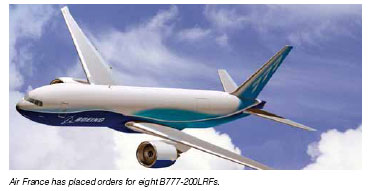
 Increased competition from Asian carriers was one factor behind weak annual results for Air France – KLM, admits its spokesman Jean-ClaudeRaynaud.
Increased competition from Asian carriers was one factor behind weak annual results for Air France – KLM, admits its spokesman Jean-ClaudeRaynaud.
“Asian carriers have developed a lot, and have started offering very signifi cant capacities and frequencies to Europe, so we have entered a period of overcapacity which is not good either for fi lling the planes or for yields,” he says. “It is not that business has declined from Asia and particularly China – it is still strong – but it is more diffi cult to make it profi table.”
The strong euro has also increased imbalances on Asian routes, something Raynamud says remains a cause of concernfor the carrier.
Overall, Air France – KLM saw cargo revenues rise less than one percent in the year to March 2007, on a 1.4 percent rise in traffi c. Operating profi ts fell by 62.7 percent to €62m. Asia was the only region to see a fall in revenues, with improvements for the Middle East and Americas, and a stable picture to andfrom Africa.
While the Franco-Dutch carrier is feeling the heat from Asian competition, this was not the only factor in the weak results, however. Raynaud also points to a big increase in belly capacity– something Air France is participatingin by deploying B777-300ERs on manyAsia routes – as well as a modal shift tosea freight.
“Sea freight has enormously improved in terms of quality of service, capacity, speed and reliability, and is now under certain circumstances a real competitor for air freight,” he says. “Shippers have also re-examined their export policy, and when there is no real hurry, they are no longer going for air.”
High fuel prices have also been making air freight less attractive, and putting the economics of Air France’s remaining B747-200 freighters under further pressure. The carrier has now accelerated the retirement of these aircraft, which until recently formed the backbone of its freighter fl eet.Two of its seven -200Fs have now been retired, and another will go in July, and the rest will leave the fl eet before the end of the year.
That will leave a gap which is being fi lled by a B747-400ERF originally intended for KLM’s fl eet but which was instead delivered to Air France in January, and by four B747-400 combi to freighter conversions, the fi rst of which arrived at the start of June. Three more -400 conversions are due to come later in the year, and Air France will lease a further -400F to supplement these. It has fi ve other production -400ERFs. Raynaud insists this will enable the carrier to maintain its current network without capacity cuts, even though it will leave Air France with only 10 freighters for a period later in the year, instead of its usual 12.
In October 2008 Air France will then get three B777-200LRFs, for which it is the launch customer, with fi ve more arriving the year afterwards. For a while these will operate alongside the ERFs, but the airline has also announced that it will phase out the latter aircraft along with its remaining 13 passenger -400s, to concentrate on the 777 for both its freighter and longhaul passenger fl eets.
Raynaud says some of the ERFs might possibly go to KLM, which will be keeping its 22 B747-400 combis for the forseeable future, but this has not been decided on.
On the subject of its proposed joint venture with China Southern, Raynaud says the two carriers are now in “exclusive bilateral talks”, with the hope of reaching agreement within six to nine months, but declines to comment further. Air France added a weekly B747- 400ERF service to Beijing at the start of the summer schedule. – Peter Conway










